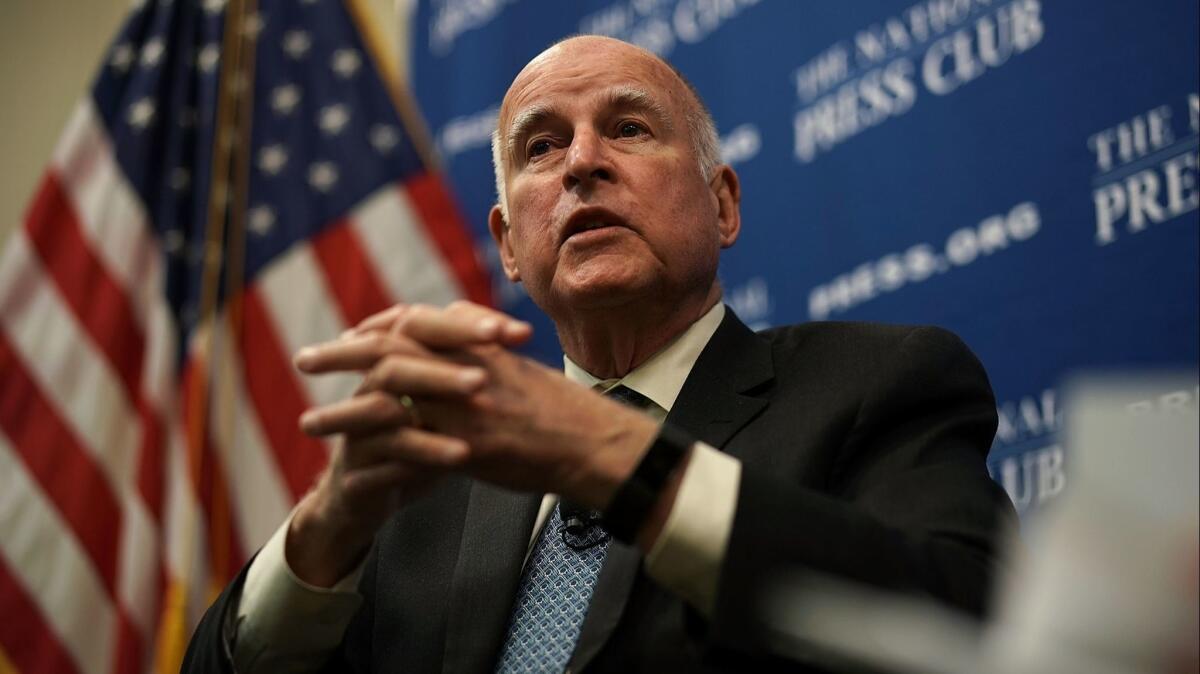Demanding action on nuclear threats, Gov. Jerry Brown will help lead group behind the Doomsday Clock

- Share via
Reporting from Sacramento — Few topics produce more fiery rhetoric from Jerry Brown, delivered with equal doses of exhortation and exasperation, than the threat posed by nuclear weapons. And as he exits the state’s political stage, California’s governor will expand his role in the global debate over nuclear disarmament.
Brown accepted an invitation Thursday to become the executive chairman of the Bulletin of the Atomic Scientists, the Chicago-based organization best known for its Doomsday Clock that is reset periodically to measure the threat of global annihilation. He will join the group’s leaders at their next meeting in early November.
“There’s no doubt we’re at one of the most dangerous, if not the most dangerous point, since the atomic bomb was first dropped,” Brown said in an interview. “There’s great and mounting hostility.”
The position is the second of its kind for the outgoing Democratic governor. Brown last year joined the board of the Nuclear Threat Initiative, an organization founded in 2001. He traveled to Washington last week for meetings at the group’s headquarters.
His trip, which ended Wednesday, also included an hourlong meeting about nuclear weapons with Defense Secretary James N. Mattis. The governor declined to say what he and Mattis discussed, but he said the secretary “affirms the dangers” posed by nuclear weapons.
“I like to deal with the big stuff,” Brown said. “And there’s nothing bigger than this.”
The role with the Bulletin also allows Brown a continued focus on climate change, as the organization states its mission is now to “support public policies that reduce manmade existential threats.” The governor convened an international climate summit in San Francisco in September.
William J. Perry, who served as Defense secretary under President Clinton and is chairman of the Bulletin’s board of sponsors, said the organization gains a passionate anti-nuclear advocate in California’s governor.
“We will put his intellect and incredible energy to good use,” Perry said in a written statement.
Could Gov. Jerry Brown be the new face of an anti-nukes campaign? He’s thinking about it »
The Bulletin was founded in 1945 by scientists who worked on the Manhattan Project, the wartime effort that led to the United States’ development of an atomic bomb. Among its early advisors were Albert Einstein and Robert Oppenheimer, the UC Berkeley physicist who helped develop the weapon of mass destruction for the U.S. military.
Brown cited Oppenheimer’s quote that “the whole world is going to hell” in noting that the dangers of nuclear war haven’t subsided in the years since — if anything, he said, the dangers have increased.
“My fellow politicians are totally asleep here,” the governor said. “We’re in a real predicament.”
Brown took sharp aim at President Trump and his national security advisor, John Bolton, over Monday’s announcement that the U.S. would soon withdraw from a landmark 1987 nuclear weapons treaty with Russia. The governor said such action is only the Republican administration’s first effort toward rekindling a global nuclear arms race.
“He is dedicated to tearing up all the nuclear agreements,” Brown said of Bolton. “Nuclear deterrence only works if there’s arms control.”
The Bulletin of the Atomic Scientists moved the hands of its symbolic Doomsday Clock this year to two minutes from apocalyptic midnight — citing threats on the Korean peninsula and the rising tension between the United States and China. In recent years, the clock’s measurement of danger has taken into consideration threats from climate change and “disruptive technologies” such as artificial intelligence.
At an event in 2015 commemorating the clock’s 70th anniversary, Brown noted parallels in the nuclear and climate threats facing the world.
“They both have catastrophic consequences,” he told an audience in Chicago. “They both are such that they don’t capture the popular imagination right now. They both take widespread collaboration across many countries.”
Brown’s anti-nuclear crusade began in the 1970s and was a common talking point during the young California governor’s second campaign for president in 1980. In a 1984 article, he wrote about the “neurotic relationship” between the U.S. and the Soviet Union over building more nuclear weapons.
“Soon, we shall either use our new weapons and die or, rejecting the outworn logic of war, find change in some form of mutual trust,” Brown wrote.
The governor won’t receive any compensation for his post with the anti-nuclear organization. The nonprofit relies largely on foundation grants and individual donors for its operating expenses. Brown rejected any suggestion in an interview with The Times that the position may be mostly ceremonial, saying he intends to “spearhead” the Bulletin’s activities in the year to come, working mostly from his rural Colusa County ranch.
“Hopefully I can pull people back from the brink,” he said.
Twitter: @johnmyers
More to Read
Get the L.A. Times Politics newsletter
Deeply reported insights into legislation, politics and policy from Sacramento, Washington and beyond. In your inbox three times per week.
You may occasionally receive promotional content from the Los Angeles Times.











